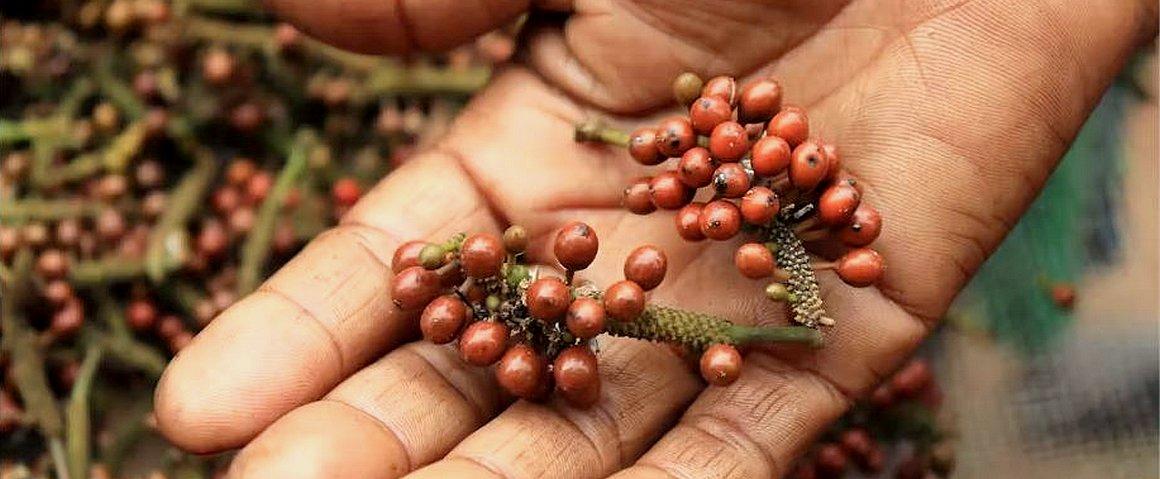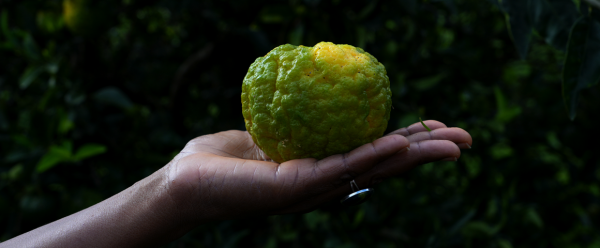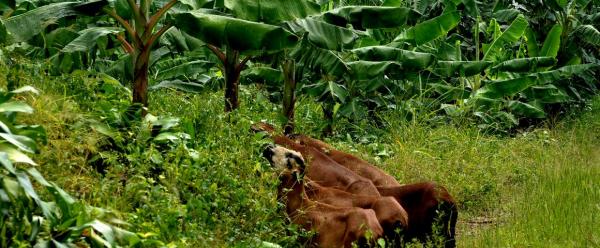Science at work 19 December 2025
- Home
- CIRAD news
- News
- Voatsiperifery, a wild pepper from Madagascar
On the trail of the world's best pepper

In Madagascar, voatsiperifery is an endemic wild pepper that is highly coveted. However, its exploitation means destroying its environment © CIRAD, J. Queste
What is voatsiperifery, the exotic spice that triple Michelin-starred chef Anne-Sophie Pic is so excited about? It is a wild pepper endemic to Madagascar, which became popular some 15 years ago.
Voatsiperifery is considered to be one of the best peppers in the world, with a virtually unique subtle taste and more flavours and scents and less pungency than other peppers. Once dried, its peppercorns give off woody, earthy and fruity aromas. It has a fresh, highly balanced flavour and scent. Voatsiperifery is a perfect illustration of the so-called "cultural" ecosystem services provided by Madagascar's natural forests and their biodiversity.
From medicine to gastronomy
While voatsiperifery does not contribute to food security, it gives pleasure to gourmets all over the world; yet another reason to invest in conserving biodiversity. It is a source of income for people living on the fringes of forests, notably during the hunger gap, the period between two harvests, in which people have hardly anything to eat as the previous crop has been used up and the next is not yet available.
It is also an ideal ambassador for Madagascar. It is the only spice exported from the country that is endemic to the main island. This wild pepper has small round or oval peppercorns that grow in clusters on long lianas in the natural forests of eastern Madagascar, from the coast to the central highlands. It is a dioecious plant, in other words male and female flowers grow on separate plants.
In Malagasy, voatsiperifery is a combination of voa, meaning "fruit", and tsiperifery, which means "which makes wounds disappear". This name stems from its medicinal use to heal wounds and refers to the peppercorns themselves, while tsiperifery refers to the plant. Voatsiperifery belongs to the family Piperaceae, is related to black pepper (Piper nigrum) and was once likened to Piper borbonense from Réunion. However, as of the date of writing, it still does not have a valid scientific name.
A history that is gathering pace
The first written references to the tsiperifery vine date back to colonial times. Texts from the 19th and early 20th centuries describe a round pepper used locally for medicinal purposes, to treat venereal diseases and colic and blacken teeth. There are still specimens collected by the first European explorers at the Muséum national d’histoire naturelle in Paris.
People living around forests traditionally pick and use tsiperifery for its culinary and medicinal properties, but also for its cultural and spiritual values. The leaves are used in rituals, to protect against lightning and prevent rain from falling. The stems and roots are made into infusions to protect against evil. In addition to preventing scarring, it is used to treat respiratory, venereal and skin diseases and sexual problems.
The exceptional flavours of voatsiperifery were discovered between 2004 and 2010 by two "spice hunters", Olivier Roellinger and Gérard Vives. Since 2010, demand has rocketed and triggered a rush towards this wild pepper. Its exploitation relies on existing collection circuits: pickers go deep into the forest and sell their harvest to collectors, who collect all sorts of forest products and sell them on to economic players who process, bag and export them. It is the collectors who capture the major share of the profits from the value chain.
However, this wild pepper is difficult to pick. In natural forests, the vines produce fruit very high up in the canopy. Ripping down the fruiting vine or felling the tree it is growing in is the simplest solution. Voatsiperifery has only recently been discovered but is already under threat of extinction and is contributing to the destruction of its habitat.
As far back as 2010, we and other Madagascan and French researchers launched several interdisciplinary research programmes aimed at rapidly acquiring knowledge to support the development of a tsiperifery export chain. This research covers the biology and ecology of the vine, its distribution area, the economics of the value chain and its processing chemistry. It has resulted in good practice handbooks for tsiperifery growing and processing.
Growing tsiperifery in natural forests
Like other non-timber forest products (NTFPs) such as mushrooms, certain barks or honey, the profits from tsiperifery should benefit the people living near forests, who are extremely vulnerable. In any event, this principle is behind the Nagoya protocol, which covers fair, equitable sharing of research results or financial returns on the exploitation of resources. In practice, the sustainability of NTFP exploitation is somewhat controversial.
In the case of tsiperifery, the picking techniques used are destructive. In Madagascan forests, NTFPs are traditionally freely accessible, hence rapidly over-exploited. The weakness of the Madagascan State makes any form of government regulation unrealistic. Value chain regulation mechanisms such as certification run up against the legal vacuum around the collection of wild products in forests.
Current research work is aimed at finding a way out of this paradigm by speeding up the tsiperifery domestication process, following the example set by other Pipers. Cultivated vines are often seen as private or associative resources, protected by the people who exploit them. This plausible promise was the working principle for two concerted research programmes led by CIRAD and FOFIFA in consultation with four villages of voatsiperifery growers.
In two of those villages, competition with other more lucrative crops – vanilla and passion fruit – led to the attempt at domestication being abandoned. In the other two, the research has served to master the first stages of propagation from cuttings and by germination.
The first surveys done three days after replanting vines in the forest showed a significant increase in tsiperifery vine density, including in zones beyond the plantations. People living around the forest have therefore stopped ripping off vines, are replanting and are monitoring the forest plots that house vines. Tsiperifery has changed status. From a freely accessible wild vine, it has become an argument in favour of forest conservation.
However, the road towards the domestication of this wild pepper is still long. The next step is to look into agronomic aspects such as fertilization, varietal breeding and crop protection. On a value chain level, local people will not grow tsiperifery unless they are sure of being able to sell their products at an acceptable price. This will undoubtedly necessitate a shift in relations between the upstream and downstream parts of the value chain.




























